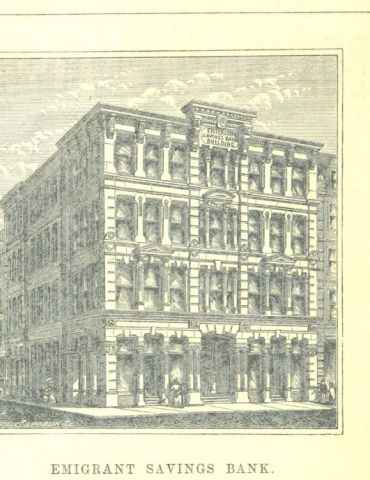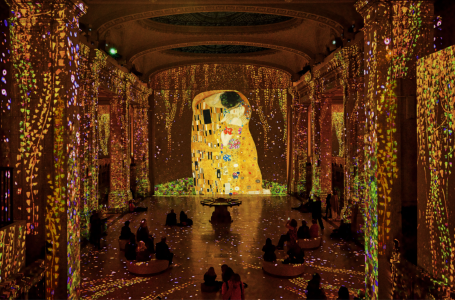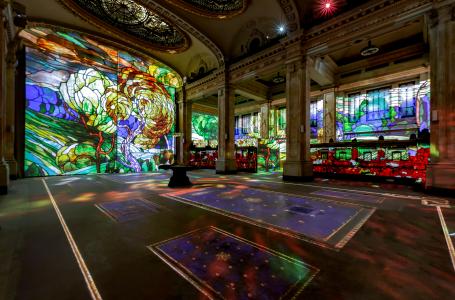Hall
des Lumières
A place of history
Hall des Lumières is located in the Beaux-Arts landmarked building located directly across from the beautiful greenspace of City Hall Park. The former bank has been redesigned and reimagined to become New York’s newest cultural destination.
1850 - The bank is established
1850
The bank is established
In the middle of the 19th century, Ireland suffered the Great Famine. New York became the home of the majority of the Irish seeking a better life. The Irish Emigrant Society, a charitable organization focused on assisting immigrants, inaugurated the Emigrant Industrial Savings Bank (now known simply as the “Emigrant Bank”) in 1850 to protect the funds of Irish immigrants.
1850 - The bank is established
Organized under the auspices of Bishop John Hughes and the Irish Emigrant Society, it was intended to protect the savings of newly arrived immigrants from unscrupulous people who might take advantage of their naivete. The bank opened in leased property at 51 Chambers Street in October 1850 and prospered.

Fermer
Emigrant Savings Bank from "Boston Illustrated", 1875, British Library
Public Domain
New quarters were erected on the site of the old buiIding in 1858. The Bank continued to grow and successfully weathered the financial panic of 1873 when several other financial institutions failed.

Fermer
New York City, Irish depositors of the Emigrant Savings Bank withdrawing money to send to their suffering relatives in the old country, 13 mars 1880, Frank Leslie's illustrated newspaper, v. 50, no. 1275, p. 29, wood engraving, Library of Congress Prints and Photographs Division Washington, D.C. 20540 USA, inv. 2012646222, Public domain
The bank extended again a few times until 1907, buying adjacent buildings from 43 to 49 Chambers Street because the available space was no longer sufficient.
1908 - The architect is chosen
1908
The architect is chosen
In 1907 the bank bought the adjoining property at 43 to 47 Chambers Street through to 21 to 25 Reade Street, and Paris-trained architect Raymond F. Almirall was employed to design a new building.
1908 - The architect is chosen

Fermer
Raymond F. Almirall
Emigrant Industrial Savings Bank Building Interior, 1909-1912, Main Floor
Public Domain

Fermer
Raymond F. Almirall, 1890, in the American Monthly Review of Reviews, vol. XXI, January-June 1900, p. 691
Bibliothèque de l'Université Toulouse 1 Capitole
Public Domain
Raymond F. Almirall (1869 - 1939) was an American architect, born in Brooklyn. After studying at the Brooklyn Polytechnic Institute and at Cornell University, he completed his training at the Ecole des Beaux-Arts in Paris, where he graduated in 1896.

Fermer
Binghamton City Hall, Collier Street, Binghamton, Broome County, NY, 1878, longitudinal section,
Library of Congress Prints and Photographs Division Washington, D.C. 20540 USA, Ohotos from Survey HABS NY-5568, inv. ny0457
Public domain

Fermer
Raymond F. Almirall, Longitudinal section of the unbuilt version of the Brooklyn Public Library, 1907, Brooklyn Public Library, Center for Brooklyn History, inv. CARN_0152
© Brooklyn Public Library (open source)
Upon his return to the United States, Almirall applied his Parisian training to the design of municipal and religious buildings. He was a creative and prolific architect, emblematic of the Beaux-Arts style.
1909 - 49 Chambers is built
1909
49 Chambers is built
In 1909, the construction of the new Emigrant Industrial Savings Bank Building begins at 49 Chambers Street.
1909 - 49 Chambers is built
Built from 1909 to 1912, it is the first skyscraper in New York City in the Beaux-Arts style. At 187 feet tall and 14 stories high, Almirall chose an H-shaped plan, which allows natural light to flood the rooms and from the outside gives the impression of a mirrored pair of towers.

Fermer
Raymond F. Almirall
Emigrant Industrial Savings Bank Building Interior,
1909-1912, Main Floor
Public Domain

Fermer
Front entrance of the Emigrant Industrial Savings Bank building, Chambers Street, New York City, 1913.
Robert L. Bracklow photograph collection, 1882-1918 (bulk 1896-1905)
New York Historical Society
More than five tons of steel were required to build the structure. In the Beaux-Arts manner, the façade displays decorative motifs inspired by various periods. At the top of each tower, below the figure of an eagle with outstretched wings, are three bronze sculptures of bees.
The majestic hall was occupied by the bank until 1969. The elegant stained-glass windows are complemented by white marble and limestone walls from Italy, punctuated by decorative bronze elements. The entire building was intended to reflect the power of the bank.
1920s - Success and crisis
1920s
Success and crisis
In the 1920s, the bank extended rapidly and celebrated its 75th year of service to the community.
1920s - Success and crisis
Before the Great Depression, the resources of the bank skyrocketed during the 1920s with over 220.000 depositors and $319.457.825 in deposits.
In 1929, the bank closed and was reused for new several functions : in 1964, the Emigrant Savings Bank Building and several surrounding plots were bought by the government of New York City. In 1973, the banking hall became the quarters of the New York City Parking Violations Bureau.
1978 - A multifunctionnal interior landmark
1978
A multifunctionnal interior landmark
In 1978, The New York City Department of Buildings planned to renovate the main hall and in the process much decorative detail would be removed.
1978 - A multifunctionnal interior landmark

Fermer
Emigrant Industrial Savings Bank
New York County, New York
Photo by: Carl Forster, 1981
New York Landmarks
Preservation Commission
Chambers Street elevation, view from the south

Fermer
Emigrant Industrial Savings Bank
New York County, New York
Photo by: Carl Forster, 1981
New York Landmarks
Preservation Commission
Chambers Street elevation, view from the south
This project of renovation was strongly criticized by Paul Goldberger an architecture writer for The New York Times, which called the banking hall "irreplaceable" and "the one real asset that this near-bankrupt city has", the city subsequently dropped the renovation plans after the public opposition.
The Landmarks Preservation Commission held a public hearing on the proposed designation of the building as an interior landmark.
Thereafter the building became an aid center in 2002 after the September 11 attacks in 2001. It even was used for the filming of movies such as Spike Lee's film Miracle at St. Anna in 2008.
2020
Hall des Lumières
Culturespaces, the European creator and manager behind the critically acclaimed ‘Atelier Des Lumières’ in Paris, announced to create, open and run the Hall des Lumières digital art center in New York from the historic 49 Chambers Street.

Fermer

Fermer
In 2021, the global architecture studio Woods Bagot begins the restoration process for the bank hall.

Fermer
© Culturespaces / Eric Spiller

Fermer
© Culturespaces / Eric Spiller
Hall des Lumières is opening on September 14, 2022 with the inaugural exhibition Gustav Klimt: Gold in Motion.

Fermer
© Culturespaces / Eric Spiller

Fermer
© Culturespaces / Eric Spiller
The immersive digital arts center presents new, innovative ways for audiences to interact with and experience artists and their work, and will showcase entirely new, custom-curated exhibitions every ten to twelve months based on the work of different world renowned artists.
Atelier des Lumières in Paris is our first marriage between digital art and a significant historic space. We are proud and excited to inaugurate Hall des Lumières, our first American center, created within the evocative setting of a Manhattan tower.
Bruno Monnier, Founder of Culturespaces



























